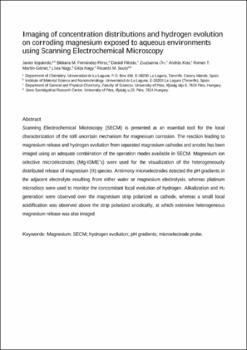Imaging of concentration distributions and hydrogen evolution on corroding magnesium exposed to aqueous environments using scanning electrochemical microscopy
Date
2016Abstract
Scanning Electrochemical Microscopy (SECM) is presented as an essential tool for the local characterization of the still uncertain mechanism for magnesium corrosion. The reaction leading to magnesium release and hydrogen evolution from separated magnesium cathodes and anodes has been imaged using an adequate combination of the operation modes available in SECM. Magnesium ion selective microelectrodes (Mg-ISME’s) were used for the visualization of the heterogeneously distributed release of magnesium (II) species. Antimony microelectrodes detected the pH gradients in the adjacent electrolyte resulting from either water or magnesium electrolysis, whereas platinum microdiscs were used to monitor the concomitant local evolution of hydrogen. Alkalization and H2 generation were observed over the magnesium strip polarized as cathode, whereas a small local acidification was observed above the strip polarized anodically, at which extensive heterogeneous magnesium release was also imaged






